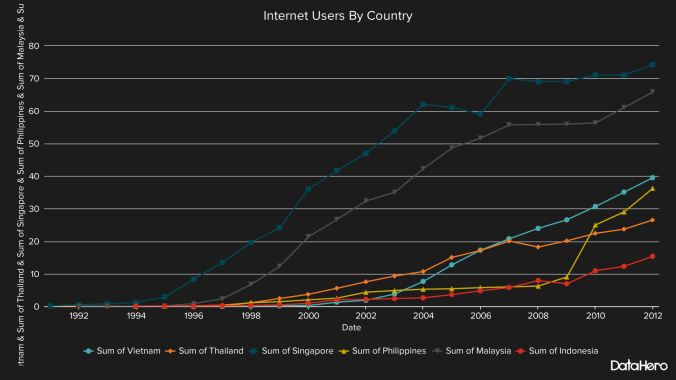Last week I found an interesting report about digital economy. It is called “Digital Evolution Index” conducted by the Fletcher School at Tufts University in collaboration with MasterCard and DataCash. Malaysia is the top in the category of “Break out” nations. It is ranked at 23 out of 50 nations and one of the fastest moving countries in the index from 2008 to 2013.
In this report, I found that only 2.9 billion global internet users receive an access to the internet so far. Remaining people cannot use the internet because there is no access to it. However, progresses of technologies are going along in many emerging countries, such as Malaysia, China and India. Let us consider these progresses country by country and what will take place in the future.
The website states that the index is calculated according to the four pillars.
1. Demand: covers consumer income and demographics as well as internet usage
2. Supply: focuses on technology and infrastructure and whether or not they can support digital commerce and transactions.
3. Institutions: accounts for government policy and access to trade.
4. Innovation: rates the environment for creating startups and the overall competitive landscape.
In short, if there are many customers using the internet, e-commerce companies, support from governments and innovations promoted, the index will be higher.
Based on the score above, countries are classified into four categories below
1. Stand Out: These countries historically achieve high levels of digital transactions and continue to maintain that level.
2. Watch Out: The common thread among these countries is that they have both significant opportunities and challenges. Their economies function well in spite of limitations.
3. Break Out: Primarily, these are developing countries that have low but growing scores. While they are attractive to investors because of rapid improvement, they’re also riskier.
4. Stall Out: Typically, this group has a history of strong growth, but it’s no longer being achieved. Because of various factors, these countries are at risk of slipping in their development.
It is no surprising that there are lots of developed nations in the category of Stand out. These are US, Canada, Singapore, Hong Kong and so on. But it is surprising that there are a lot of Asian nations in the category of Break Out. These are Malaysia, Thailand, China. Although India, Philippines, Vietnam and Indonesia are in Watch Out, they very close to Break Out. As you know, China and India have populations over a billion people and ASEAN nations have also six hundred million populations there. It means that the digital economy will be spread out with massive scale there in the future. Especially when android phones are getting cheaper and everyone can afford his/her smart phone in order to connect to the internet.
I live and work in Kuala Lumpur, Malaysia. I agree with this index as mobile internet is very proficient and the cost is reasonable here. I pay 30RG (1USD is about 3.6 RG) per month to connect to the internet and voice telephone through my mobile. The speed of the internet is enough to use e-mails and social network, although it is a little dull to watch the movies. 4G internet service is likewise available if you pay more.
From Malaysia to India, there is vast potential to expand digital economy. I would like to find out “the next billion users” there.




